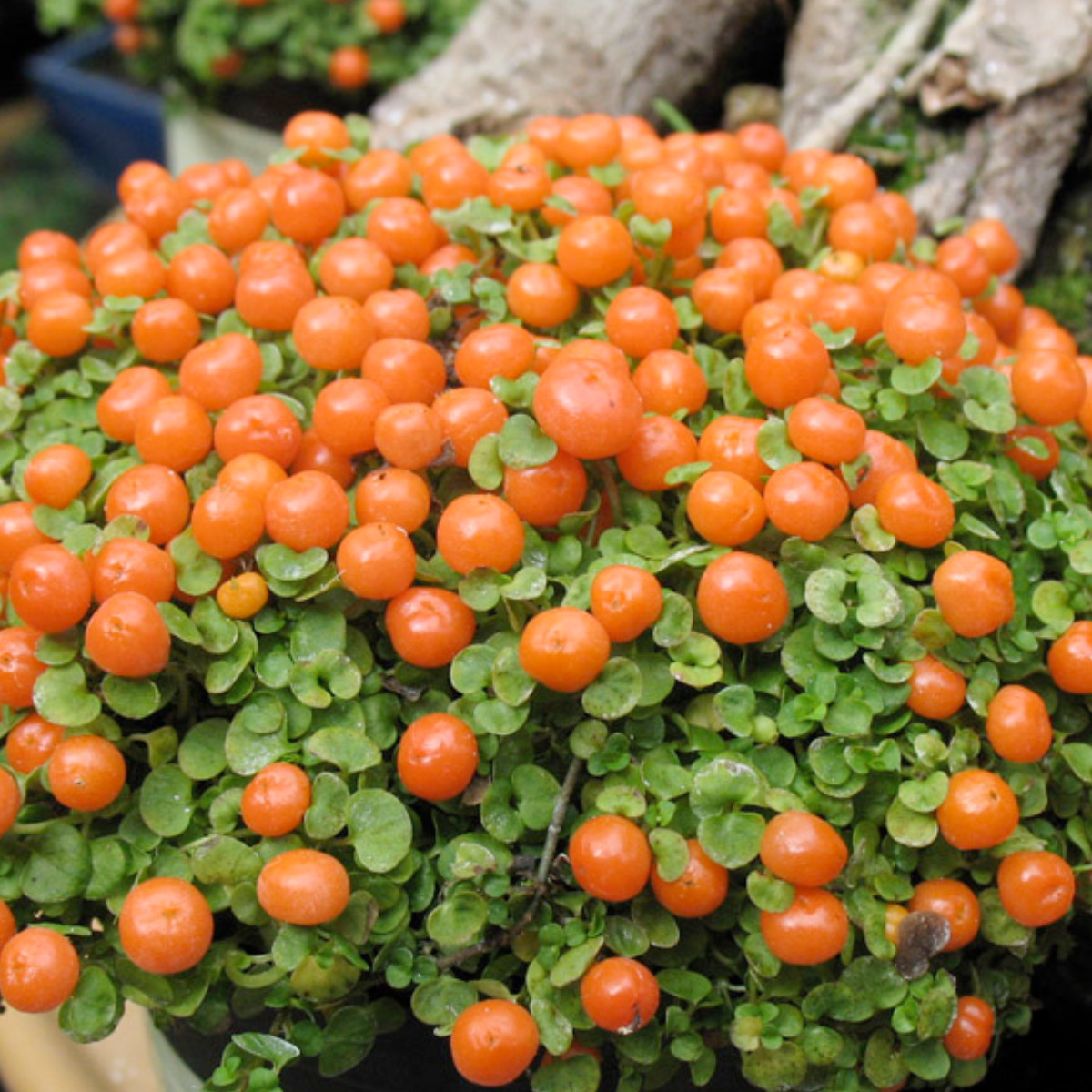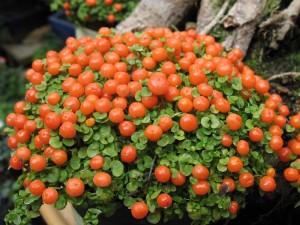Common name: Coral Bead Plant, Pin-Cushion Plant, Coral Moss, English Baby Tears, Bead Plant, Hardy Baby Tears
Family: Rubiaceae
Synonymous: Coprosma dentata
Coprosma granadensis
Coprosma nertera
Coprosma nigricarpa
Coprosma taiwaniana
Cunina sanfuentes
Erythrodanum alsiniforme
Erythrodanum majus
Geoherpum alsinifolium
Gomozia americana
Gomozia granadensis
Hemiphragma heterophyllum var. dentatum
Logania dentata
Mitchella ovata
Nertera adsurgens
Nertera assurgens
Nertera dentata
Nertera depressa
Nertera montana
Nertera nigricarpa
Nertera repens
Nertera taiwaniana
Nertera tetrasperma
Peratanthe cubensis
Peratanthe ekmanii
Distribution and habitat: Nertera granadensis has an unusually extensive transcontinental distribution surrounding the Pacific Ocean, occurring from southern Chile and western Argentina north to Guatemala, and in New Zealand, eastern Australia, Indonesia, Malaysia, Papua New Guinea, the Philippines and Taiwan. In the tropical regions of the western Pacific, Nertera granadensis only occurs at high altitudes.
Description: Nertera granadensis are very decorative creeping plants which have pea-size, orange coloured berries. It is the only Nertera species grown indoors. The thin, closely matted stems of this plant run along the surface of the potting mixture, rooting into the mixture at the nodes. The stems, which can grow up to 25cm (10 inch) long, carry medium green, broadly oval, fleshy, stalkless leaves up to a centimetre (0.4 inch) across. A fully mature plant is likely to form a low mound 5-8cm (2-3 inch) high.
Insignificant and stalkless flowers, which are produced in early summer, appear from leaf axils. The flowers are tiny and greenish yellow and they give way to shiny, orange-red berries about a centimetre (0.4 inch) in diameter. These berries are fully developed by late summer and they remain on the plant for several months. They are often so numerous that they almost hide the foliage.
Houseplant care: As a house plant, Nertera granadensis is somewhat difficult to maintain and it is not recommended for beginners.
Many home gardeners treat Nertera granadensis as annuals, disposing them and replacing older specimens with new ones every year. It is not necessary to do this, however. Under the right conditions Nertera granadensis can normally be kept quite healthy for a number of years.
Light: Grow Nertera granadensis in bright light, making sure that they gets at least three hours of direct sunlight every day.
Temperature: Nertera granadensis will flower and set fruit best if kept in an airy position at a temperature of 10-15C (50-59F). Ideally these plants should be kept outdoors throughout the months from late spring until the berries have formed. When placing them outdoors be sure to choose a position where they get some direct sunlight and are sheltered from the summer storms. Indoors they can tolerate warmer conditions than the recommended temperature range. But they will grow very fast in warm rooms and produce too much foliage.
To bear flowers and berries successfully, Nertera granadensis require high humidity. While they are kept indoors, stand the pots on trays or saucers of moist pebbles. Spray plants lightly with water once a day from time that flowers begin to appear until all berries are fully developed.
Water: Water moderately, giving enough at each watering to make the potting mixture thoroughly moist, but allowing the top centimetre (0.4 inch) or so to dry out before watering again.
These plants should never be allowed to dry out completelly, not even during the rather short winter rest period. While plants are resting, continue moderate watering, but allow the top couple of centimetres (0.8 inch) of the mixture to dry out between waterings.
Feeding: Excessive feeding stimulates the growth of the foliage at the expense of flowers and berries. Apply standard liquid fertiliser to these plants only during the few summer months between the end of the flowering period and the time when berries are fully matured. Even then, be sure not to apply fertiliser to the plants more often than once a month.
Potting and repotting: Use a combination of two-thirds of soil-based potting mixture and one-third of an equal-parts mixture of peat-moss and coarse sand or perlite. Nertera granadensis are normally grown in 8cm (3 inch) pots. Because they have relatively shallow roots, however, they are more suitably grown in shallow 8-10cm (3-4 inch) containers and they need never be moved into larger containers.
Propagation: Commercially, these plants are normally grown from seed, but this is a slow and not very dependable process. Instread divide old plants in spring, setting five or six small clumps of stems around the edge of a 10cm pan containing standard mixture. Alternativelly, plant short tip cuttings (2.5-5cm (1-2 inch) long) together in a 5cm (2 inch) pot containing an equal-parts mixture of moistened peat moss and sand.
Enclose the cuttings in either a plastic bag or a propagating case and place them in bright filtered light at a temperature of about 15C (59F). When renewed top growth indicates that roots are well established, move each group of cuttings directly into a 8cm (3 inch) pot of recommended mixture for adult specimens, after which the needs of the young plants are generally those of mature Nertera granadensis.
Toxicity: The plant possesses brightly colored fruit and likely offers visual appeal to young children and pets. Fortunately, the toxicity of Nertera granadensis appears to be quite low. There are no known toxins associated with the particular parts of the plant.
SUMMARY:
CHARACTERISTICS:
Foliage green
Features flowers & fruits
Shape climbing and trailing
Height: 8cm (3 inch)
PROPER CARE:
Watering in rest period moderately
Watering in active growth period moderately
Light bright
Temperature in rest period min 7C max 16C (45-61F)
Temperature in active growth period min 10C max 18C (50-64F)
Humidity high
Hardiness zone: 9a-11
Begonia propagation f...
Essential Nutrients f...
Portulacaria afra
Tillandsia recurvata
Tillandsia stricta
Columnea microphylla
Clivia miniata
Cleyera japonica
Clerodendrum thomsoni...
Cleistocactus strausi...



